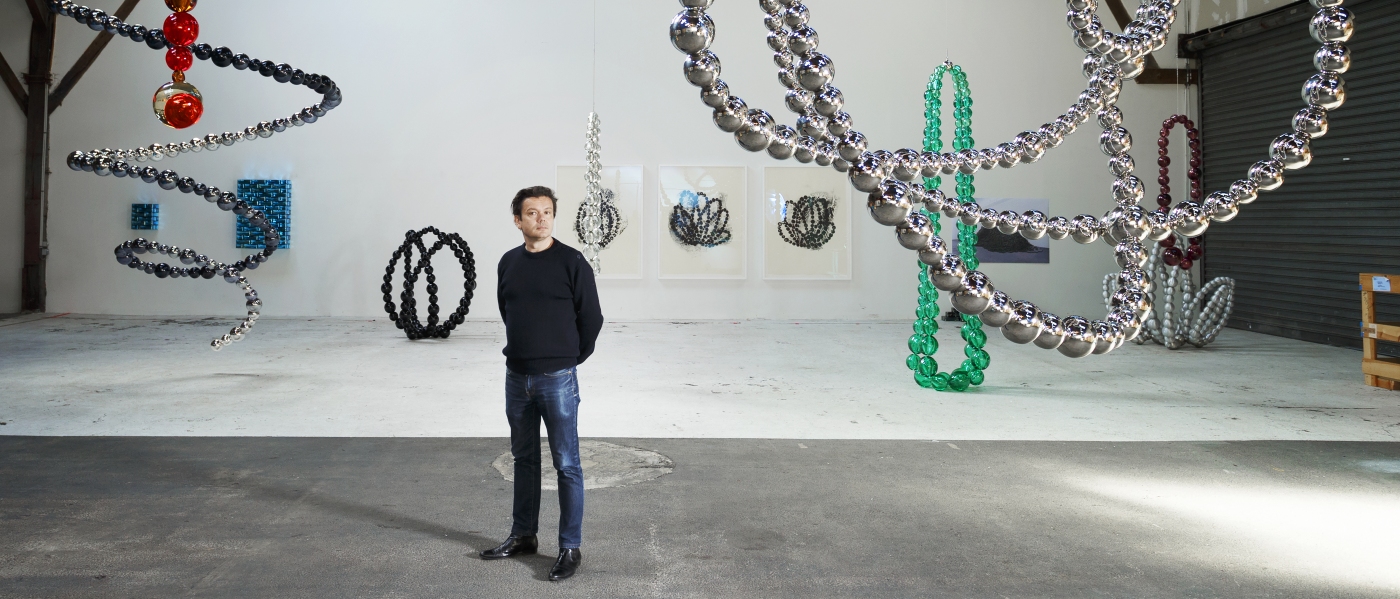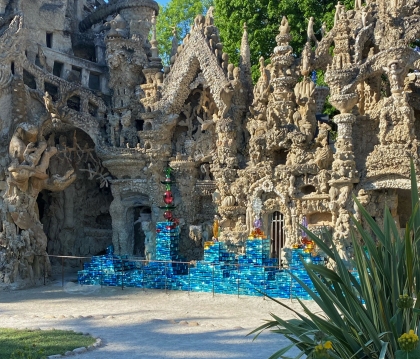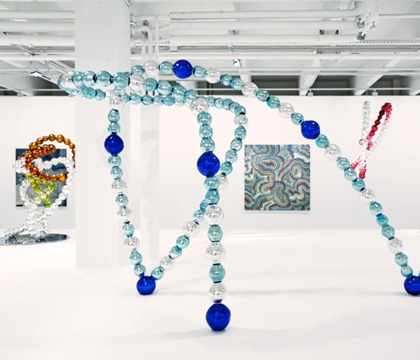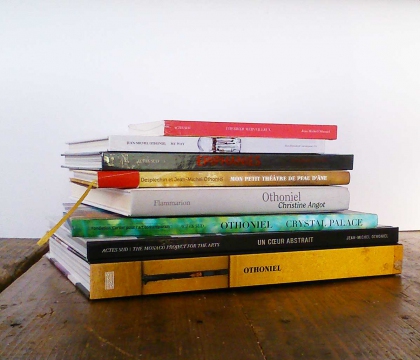Jean-Michel Othoniel
Born in 1964 in Saint-Étienne.
Lives and works in Paris.
Since the end of the 1980s, Jean-Michel Othoniel has been inventing a world that ranges from drawing to sculpture, from installation to photography, from writing to performance. He first explored materials with reversible qualities such as sulfur and wax, and has been working in glass since 1993. His current work, which comprises both public and private commissions, takes on an architectural dimension, creating installatons in gardens and historical sites the world over.
Metamorphoses, sublimations and transformations
In the early 1990s, Jean-Michel Othoniel began working with reversible materials such as wax or sulfur, making poetic works that were presented by Jan Hoet at the Documenta Kassel in 1992. The following year, when he began using glass, marks a major turning point in his work, collaborating with artisan glassblowers from Murano. The glass' delicacy and subtle colours dovetailed with the artist’s desire to romanticise and re-enchant the world.
In 1994, he participated in the exhibition “Féminin/Masculin” (“Feminine/Masculine”) at the Centre Georges Pompidou in Paris, presenting a series of works in sulphur as well as My Beautiful Closet, an installation/performance featuring dancers filmed in a dark cupboard. In 1996, he was granted a residency at the Villa Medicis in Rome. He then began creating works that interact with the landscape, suspending giant necklaces, for instance, in the Villa Medicis gardens; in the trees outside the Peggy Guggenheim Collection in Venice (1997); or at the Alhambra, Palace of the Generalife in Granada (1999). Like forbidden fruits, his works merge into the landscape and foliage as if growing organically, absorbing shadows and diffusing the light.
Between museums and public spaces
In 2000, Jean-Michel Othoniel received his first public commission: to transform the Parisian subway station at Palais-Royal – Musée du Louvre, a century after Hector Guimard. In his installation, Le Kiosque des Noctambules (The Kiosk of the Nightwalkers), two glass and aluminum crowns conceal a bench that invites random encounters while the city sleeps.
His creations have since graced both public squares and museum spaces; site-specific works or exhibitions have become opportunities to test the many possibilities provided by his chosen materials and develop his favorite themes.
In 2003, for the exhibition “Crystal Palace,” presented at the Cartier Foundation for Contemporary Art in Paris, at the MOCA in Miami, in Venice and at the International Glass Centre in Marseille (Cirva), he produced enigmatic sculptures in blown-glass shapes that lie between jewellery, architecture and erotic objects. The following year, in 2004, an invitation to exhibit in the spectacular Mesopotamian rooms in the Louvre Museum, for the exhibition “Contrepoint,” offered him an opportunity to produce his first freestanding necklaces, including the large-scale Rivière Blanche (White River), made of beads adorned with nipples, which was acquired by the Museum of Modern Art of the City of Paris.
Travelling Artwork
Since 1991-- when, during a long voyage to Hong Kong, Jean-Michel Othoniel installed a temporary studio on the roof of the Museum of Contemporary Art to preparefor the exhibition “Too French”-- travelling has become a recurring part of his work. He retains a fondness for nomadic, producing pieces with glassblowers in Mexico, Japan and India. The idea of travel is also reflected in his project Le Petit Théâtre de Peau d’Âne (2004, Centre Pompidou collection), inspired by small puppets found in the house of the great traveller Pierre Loti and presented onstage at the Théâtre de la Ville in Rochefort, then the Théâtre du Châtelet in Paris.
The artist's sculpture Bateau de Larmes (Boat of Tears) mixes the political and the intimate. In a tribute to exiled people, Othoniel saved a salvaged Cuban refugee boat that had been abandoned in Miami and covered it with cascades of colourful glass beads, like huge, crystal tears. This work was shown at Art Unlimited 2005, at the entrance of the Art Basel exhibition.
During a visit to India in 2010, Othoniel worked with glassmakers in Firozabad, producing a series that was presented the following year in his retrospective exhibition “My Way” at the Centre Georges Pompidou in Paris, which retraced his career following his graduation from the École des Beaux-arts in Cergy-Pontoise in 1988. “My Way” was then presented in 2011 at the Leeum Samsung Museum of Art/Plateau in Seoul, and the following year at the Hara Museum of Contemporary Art in Tokyo, the Macao Museum of Art in Macao and the Brooklyn Museum in New York.
Interacting with history and the contemporary
In 2012, an invitation from the Eugène Delacroix Museum, in the painter's former apartment and studio in Paris, offered Othoniel an opportunity to dialogue with this historic location. He showed a series of sculptures inspired by the structure of flowers and watercolours from his book Herbier Merveilleux, which explores the symbolism of flowers in texts and images.
Othoniel's installations and site-specific sculptures reflect the beauty of a place and heighten its magical qualities. In the spring of 2013, the Mori Art Museum in Tokyo commissioned Kin no Kokoro, a monumental heart of gilded bronze beads, in which Othoniel associates the recurring themes in his work with Eastern sacred symbolism. A celebration of the museum's 10th anniversary, the sculpture is permanently installed in the museum's Mohri Garden. The same year, as part of a development project along the banks of the Saône in Lyon on the former Caluire-et-Cuire lock, he created a belvedere of coloured-glass beads that reflects the lanterns on the nearby Île Barbe.
In 2014, Othoniel undertook a monumental project: the redevelopment of the Water Theatre grove in the gardens of the Chateau de Versailles. For this commission, awarded in an international competition and in collaboration with the landscape designer Louis Benech, Jean-Michel Othoniel created three fountain sculptures in gilded glass. Inspired by the work of choreographer Raoul-Auger Feuillet, dancing master for the court of King Louis XIV, Les Belles Danses (The Beautiful Dances) is the first permanent installation ever commissioned for the palace by a contemporary artist. These three fountain sculptures embody the qualities of Othoniel's recent work: monumentaity, relationship to history and innovation.
In September 2016, Jean-Michel Othoniel unveiled a total and monumental work of art, The Treasury of Angoulême Cathedral, on which he worked for more than eight years.
In 2018, he created Alfa, an installation for the new National Museum of Qatar, designed by architect Jean Nouvel. For this project, conceived on the same monumental scale as the building, he designed 114 fountain sculptures spraying water that evokes the fluid shapes in Arabic calligraphy.
In September 2019, at the Musée du Louvre, Jean-Michel Othoniel presented a new series of paintings for the walls of the Cour Puget sculpture courtyard, created specifically for the thirtieth anniversary of the pyramid. Since then, the museum decided to make these works part of its permanent collection.
In 2021, on the invitation of the Petit Palais, Othoniel took over its garden and the galleries housing its permanent collections and presented an exhibition that brought the museum’s architecture into play. “Le Théorème de Narcisse” (The Theorem of Narcissus) offered visitors a journey of wonderment. At the same time, the artist inaugurated a new public artwork, his Tour d’Or Blanc (The Tower of White Gold), in Amboise, France, created in collaboration with the winegrowers in the Loire Valley.
In 2021, the artist was also honored in an official ceremony marking his induction into the Académie des Beaux-Arts, dedicated to the fine arts, which encourages artistic creation and ensures the defense of France's cultural heritage.
This year, 2022, his exhibition in Seoul at the SeMA and the Imperial Palace garden “Treasure gardens” keeps going to show the important place of garden in his work.
Othoniel is frequently called upon by contemporary architects, including Peter Marino and Jean Nouvel, to create site-specific artworks at historical sites.
Jean-Michel Othoniel is represented by : Galerie Perrotin (Paris, New York and Hong Kong) and Kukje Gallery (Seoul). His works can be found in important contemporary art museums, foundations and private collections around the world.



